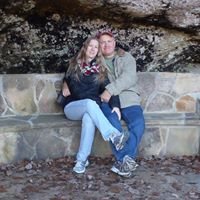Michael Gary Driver
age ~51
from Smithville, MO
- Also known as:
-
- Michael G Driver
- Mike G Driver
- Phone and address:
-
15614 Quail Ridge Dr, Smithville, MO 64089
4178878605
Michael Driver Phones & Addresses
- 15614 Quail Ridge Dr, Smithville, MO 64089 • 4178878605
- Glassboro, NJ
- Williamstown, NJ
- Kirksville, MO
- Mill Valley, CA
- Branson West, MO
- Springfield, MO
- Protem, MO
- Battlefield, MO
- Saint Louis, MO
- Greenview, MO
- Tucson, AZ
Work
-
Company:RE/MAX of Greensboro
-
Address:204 Muirs Chapel Road
-
Phones:3362988289 3368542170
Images
Specialities
Buyer's Agent • Listing Agent • Foreclosure • Property Management
Real Estate Brokers

Michael Driver, Greensbro NC Realtor, Broker, Licensed in South Carolina
view sourceSpecialties:
Buyer's Agent
Listing Agent
Foreclosure
Property Management
Listing Agent
Foreclosure
Property Management
Work:
RE/MAX of Greensboro
204 Muirs Chapel Road
3362988289 (Office), 3362988289 (Cell), 3368542170 (Fax)
204 Muirs Chapel Road
3362988289 (Office), 3362988289 (Cell), 3368542170 (Fax)
Experience:
14 years
Licenses:
67516 (Licensed in South Carolina)
Links:
Site
Blog
Facebook
Twitter
LinkedIn
Blog
Medicine Doctors

Michael K. Driver
view sourceSpecialties:
Emergency Medicine
Work:
Clarkston Emergency PhysClarkston Emergency Physicians
1221 Highland Ave, Clarkston, WA 99403
5097584665 (phone), 5097584065 (fax)
1221 Highland Ave, Clarkston, WA 99403
5097584665 (phone), 5097584065 (fax)
Education:
Medical School
Oregon Health & Science University School of Medicine
Graduated: 1980
Oregon Health & Science University School of Medicine
Graduated: 1980
Procedures:
Arthrocentesis
Lumbar Puncture
Vaccine Administration
Lumbar Puncture
Vaccine Administration
Conditions:
Acute Upper Respiratory Tract Infections
Fractures, Dislocations, Derangement, and Sprains
Migraine Headache
Otitis Media
Skin and Subcutaneous Infections
Fractures, Dislocations, Derangement, and Sprains
Migraine Headache
Otitis Media
Skin and Subcutaneous Infections
Languages:
English
Description:
Dr. Driver graduated from the Oregon Health & Science University School of Medicine in 1980. He works in Clarkston, WA and specializes in Emergency Medicine. Dr. Driver is affiliated with Tri-State Memorial Hospital.
Isbn (Books And Publications)

The Dynamic Decision Maker: Five Decision Styles for Executive and Business Success
view sourceAuthor
Michael J. Driver
ISBN #
0608216038

The Dynamic Decision Maker: Five Decision Styles for Executive and Business Success
view sourceAuthor
Michael J. Driver
ISBN #
0887302971
Us Patents
-
Separation Of Olefins From Paraffins Using Ionic Liquid Solutions
view source -
US Patent:6339182, Jan 15, 2002
-
Filed:Dec 12, 2000
-
Appl. No.:09/735176
-
Inventors:Curtis L. Munson - Oakland CA
Laura C. Boudreau - Lafayette CA
Michael S. Driver - San Francisco CA
William L. Schinski - San Rafael CA -
Assignee:Chevron U.S.A. Inc. - San Ramon CA
-
International Classification:C07C 700
-
US Classification:585809, 585843, 585845, 585849, 585850, 585848, 208219, 208223
-
Abstract:Methods for separating olefins from non-olefins, such as parafins, including cycloparaffins, oxygenates and aromatics, are provided. The methods use metal salts to complex olefins, allowing the non-olefins to be separated by a variety of methods, including decantation and distillation. The metal salts are dissolved in ionic liquids, which tend to have virtually no vapor pressure, and which poorly solubilize the non-olefins. Accordingly, the non-olefins phase separate well, and can be distilled without carrying over any of the ionic liquid into the distillate. Preferred salts are Group IB salts, more preferably silver salts. A preferred silver salt is silver tetrafluoroborate. Preferred ionic liquids are those which form stable solutions or dispersions of the metal salts, and which do not dissolve the non-olefins. Further, if the olefins are subject to isomerization, the ionic liquid is preferably relatively non-acidic. The methods involve forming a solution of a suitable olefin-complexing salt in an appropriate ionic liquid.
-
Process For Making Fatty Acid Nitriles And Fatty Amines By Cross-Metathesis Of Normal Alpha Olefins
view source -
US Patent:6380420, Apr 30, 2002
-
Filed:Sep 8, 2000
-
Appl. No.:09/657859
-
Inventors:William L. Schinski - San Rafael CA
Michael S. Driver - San Francisco CA -
Assignee:Chevron U.S.A. Inc. - San Ramon CA
-
International Classification:C07C20948
-
US Classification:558308, 558357, 558457, 558462, 564490, 564491, 564492, 564493
-
Abstract:A process for preparing fatty amines by the cross-metathesis of normal alpha olefins and acrylonitrile to form an intermediate fatty acid nitrile which is hydrogenated to the corresponding fatty amine.
-
Process For Increasing The Yield Of Lubricating Base Oil From A Fischer-Tropsch Plant
view source -
US Patent:6605206, Aug 12, 2003
-
Filed:Feb 8, 2002
-
Appl. No.:10/071281
-
Inventors:David R. Johnson - Petaluma CA
Christopher A. Simmons - El Cerrito CA
Donald H. Mohr - Orinda CA
Stephen J. Miller - San Francisco CA
Stephen K. Lee - Oakland CA
William L. Schinski - San Rafael CA
Michael S. Driver - San Francisco CA -
Assignee:Chevron U.S.A. Inc. - San Ramon CA
-
International Classification:C10G 6717
-
US Classification:208 80, 208 78, 208950, 585304, 585327
-
Abstract:A process for increasing the yield of C plus hydrocarbon products from a Fischer-Tropsch plant which comprises the steps of (a) separating a Fischer-Tropsch product into a wax fraction and a condensate fraction; (b) dewaxing the wax fraction to produce a high boiling intermediate; (c) hydrofinishing the high boiling intermediate; (d) dehydrating the alcohols in the condensate fraction to convert them into olefins; (e) oligomerizing the olefins to form higher molecular weight hydrocarbons; (f) hydrofinishing the oligomerization mixture; and (g) and recovering a C plus hydrocarbon product from the hydrofinishing zone.
-
Separation Of Olefins From Paraffins Using Ionic Liquid Solutions
view source -
US Patent:6623659, Sep 23, 2003
-
Filed:Dec 3, 2001
-
Appl. No.:09/998138
-
Inventors:Curtis L. Munson - Oakland CA
Laura C. Boudreau - Lafayette CA
Michael S. Driver - San Francisco CA
William L. Schinski - San Rafael CA -
Assignee:Chevron U.S.A. Inc. - San Ramon CA
-
International Classification:C09K 300
-
US Classification:252184, 585856, 585857
-
Abstract:Methods for separating olefins from non-olefins, such as paraffins, including cycloparaffins, oxygenates and aromatics, are provided. The methods use metal salts to complex olefins, allowing the non-olefins to be separated by a variety of methods, including decantation and distillation. The metal salts are dissolved in ionic liquids, which tend to have virtually no vapor pressure, and which poorly solubilize the non-olefins. Accordingly, the non-olefins phase separate well, and can be distilled without carrying over any of the ionic liquid into the distillate. Preferred salts are Group IB salts, more preferably silver salts. A preferred silver salt is silver tetrafluoroborate. Preferred ionic liquids are those which form stable solutions or dispersions of the metal salts, and which do not dissolve the non-olefins. Further, if the olefins are subject to isomerization, the ionic liquid is preferably relatively non-acidic. The methods involve forming a solution of a suitable olefin-complexing salt in an appropriate ionic liquid.
-
Process For Upgrading Fischer-Tropsch Syncrude Using Thermal Cracking And Oligomerization
view source -
US Patent:6703535, Mar 9, 2004
-
Filed:Apr 18, 2002
-
Appl. No.:10/125879
-
Inventors:David R. Johnson - Petaluma CA
Christopher A. Simmons - El Cerrito CA
Donald H. Mohr - Orinda CA
Stephen J. Miller - San Francisco CA
Stephen K. Lee - Oakland CA
William L. Schinski - San Rafael CA
Michael S. Driver - San Francisco CA
William J. Cannella - Hercules CA -
Assignee:Chevron U.S.A. Inc. - San Ramon CA
-
International Classification:C07C 204
-
US Classification:585303, 585302, 585304, 585329, 585330, 208950
-
Abstract:A process for upgrading a Fischer-Tropsch feedstock which comprises (a) recovering from a Fischer-Tropsch reactor a Fischer-Tropsch wax fraction and a Fischer-Tropsch condensate fraction, wherein the Fischer-Tropsch condensate fraction contains alcohols boiling below about 370Â C. ; (b) contacting the Fischer-Tropsch condensate fraction with a dehydration catalyst in a dehydration zone under dehydration conditions pre-selected to convert at least some of the alcohols present in said fraction into olefins and recovering a first intermediate effluent from said dehydration zone; (c) pyrolyzing the paraffins in the Fischer-Tropsch wax fraction in a thermal cracking zone under thermal cracking conditions pre-selected to crack the Fischer-Tropsch wax molecules to form olefins and collecting a second intermediate effluent from the thermal cracking zone; (d) passing the first and second intermediate effluents recovered from steps (b) and (c) to an oligomerization zone containing an oligomerization catalyst under oligomerization conditions to form an oligomerization mixture having a higher molecular weight than either of said first and second intermediate effluent; (e) hydrofinishing the oligomerization mixture in a hydrofinishing zone; and (f) recovering from the hydrofinishing zone a C plus hydrocarbon product, most preferably a lubricating base oil.
-
Alkylation Process Using An Alkyl Halide Promoted Ionic Liquid Catalyst
view source -
US Patent:7531707, May 12, 2009
-
Filed:Dec 13, 2006
-
Appl. No.:11/610006
-
Inventors:Thomas V. Harris - Benicia CA, US
Michael Driver - San Francisco CA, US
Saleh Elomari - Fairfield CA, US
Hye-Kyung C. Timken - Albany CA, US -
Assignee:Chevron U.S.A., Inc - San Ramon CA
-
International Classification:C07C 2/60
C07C 2/62 -
US Classification:585906, 585725, 585727, 585728, 585724
-
Abstract:A process for the production of a high quality gasoline blending components from refinery process streams by the alkylation of light isoparaffins with olefins using an ionic liquid catalyst is disclosed. The alkylation process comprises contacting a hydrocarbon mixture comprising at least one olefin having from 2 to 6 carbon atoms and at least one isoparaffin having from 3 to 6 carbon atoms under alkylation conditions, said catalyst comprising a mixture of at least one acidic ionic liquid and at least one alkyl halide. The alkylhalide by reacting to at least a portion of the olefin with a hydrogen halide.
-
Reduction Of Organic Halides In Alkylate Gasoline
view source -
US Patent:7538256, May 26, 2009
-
Filed:Dec 12, 2006
-
Appl. No.:11/609739
-
Inventors:Michael S. Driver - San Francisco CA, US
Gunther Dieckmann - Walnut Creek CA, US -
Assignee:Chevron U.S.A., Inc. - San Ramon CA
-
International Classification:C07C 2/60
C07C 2/62 -
US Classification:585712, 585725, 585727, 585728, 585724
-
Abstract:An alkylation process comprising contacting a first hydrocarbon feed comprising at least one olefin having from 2 to 6 carbon atoms and a second hydrocarbon feed comprising at least one isoparaffin having from 3 to 6 carbon atoms with a halide-based acidic ionic liquid catalyst under alkylation conditions to produce an alkylate containing an organic halide and contacting at least a portion of the alkylate with a hydrotreating catalyst in the presence of hydrogen under hydrotreating conditions to reduce the concentration of the organic halide is disclosed.
-
Method Of Making An Alkylated Aromoatic Using Acidic Ionic Liquid Catalyst
view source -
US Patent:7732651, Jun 8, 2010
-
Filed:Jun 1, 2006
-
Appl. No.:11/445561
-
Inventors:Michael Driver - San Francisco CA, US
Curt B. Campbell - Hercules CA, US
Thomas V. Harris - Benicia CA, US -
Assignee:Chevron Oronite Company, LLC - San Ramon CA
-
International Classification:C07C 2/70
C07C 2/26 -
US Classification:585323, 585455, 585456, 585521, 585511
-
Abstract:A process for alkylating an aromatic compound containing no hydroxyl groups comprising reacting at least one non-hydroxyl containing aromatic compound with at least one olefinic oligomer in the presence of an acidic ionic liquid catalyst, wherein the olefinic oligomer has a carbon range of from about Cto about Cand is synthesized by oligomerizing at least one monoolefin monomer in the presence of an acidic ionic liquid catalyst.
Resumes

Michael Driver
view source
Michael Aserov Bodyguard Driver
view source
Michael Driver
view source
Michael Driver
view source
Michael Driver
view source
Michael Driver
view source
Michael Driver
view sourceName / Title
Company / Classification
Phones & Addresses
Treasurer
NANEUM LIMITED
Lawyers & Attorneys
License Records
Michael Gary Driver
Address:
Smithville, MO 64089
License #:
MD456183 - Active
Category:
Medicine
Type:
Medical Physician and Surgeon

Michael Driver
view source
Michael Raymd Driver
view source
Michael Scott Driver
view source
Michael Driver
view source
Dte Michael Driver
view source
Michael Driver
view source
Michael A Driver
view source
Brand Michael Driver
view sourceYoutube
Plaxo

Michael Driver
view source
Michael Driver
view sourcePatton Boggs

Michael Driver
view sourceProprietor at MS2 Architectural consultants
Flickr
Googleplus

Michael Driver
Relationship:
Married

Michael Driver

Michael Driver

Michael Driver

Michael Driver

Michael Driver

Michael Driver

Michael Driver
Myspace
Classmates

Michael Driver
view sourceSchools:
Ethel R. Jones Elementary School Portage IN 1970-1975, Grissom MIddle School Portage IN 1975-1979
Community:
Edna Maturkanich, Rod Dennison, Kevin Durning

Michael Driver
view sourceSchools:
Washington Junior High School Pensacola FL 1985-1989
Community:
George Pierce

Michael Driver
view sourceSchools:
Osborne High School Marietta GA 1967-1971
Community:
John Neff, Chris Schnick

Michael Driver
view sourceSchools:
Arlington High School 722 Indianapolis IN 1980-1984
Community:
Jerry Glass

Michael Driver
view sourceSchools:
Bibb County High School Centreville AL 1996-2000
Community:
Kenny Johnson

Michael Driver
view sourceSchools:
Lafayette High School Mayo FL 1994-1998
Community:
Norma Cobb, Michael Wilder, Edward Thomas, Donna Land

Michael Driver
view sourceSchools:
Pfeiffer College Misenheimer NC 1965-1969
Community:
Christy Yow, Patricia Smith, James Deramus, Charles Licari, Laurence Campbell, William Cash, Bonnie Kirby, Judy Beaver, Edward Cramer, Mandel Lesourd, Wiley Huneycutt

Michael Driver, Portage H...
view sourceGet Report for Michael Gary Driver from Smithville, MO, age ~51





















